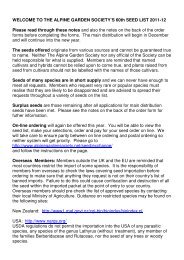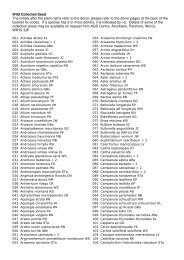Easy Bulbs to buy in autumn - Alpine Garden Society
Easy Bulbs to buy in autumn - Alpine Garden Society
Easy Bulbs to buy in autumn - Alpine Garden Society
Create successful ePaper yourself
Turn your PDF publications into a flip-book with our unique Google optimized e-Paper software.
Volume: 03<br />
AGS © 2008 Tel: 01386 554790<br />
Info Leaflet: <strong>Easy</strong> bulbs <strong>to</strong> <strong>buy</strong> <strong>in</strong> <strong>autumn</strong><br />
<strong>Easy</strong> <strong>Bulbs</strong> <strong>to</strong> <strong>buy</strong> <strong>in</strong> <strong>autumn</strong><br />
The bulb trade has been flourish<strong>in</strong>g for centuries, and<br />
the range of bulbs on sale is so large that the beg<strong>in</strong>ner<br />
can be <strong>to</strong>tally overwhelmed by the choice available,<br />
some at very high prices. Add <strong>to</strong> this the range of<br />
nurserymen attend<strong>in</strong>g AGS shows who specialise <strong>in</strong><br />
dwarf bulbs and it is difficult <strong>to</strong> know where <strong>to</strong> beg<strong>in</strong>.<br />
So why beg<strong>in</strong> <strong>to</strong> grow bulbs?<br />
• Many bulbs are very easy <strong>to</strong> grow and cheap <strong>to</strong> <strong>buy</strong>, so represent excellent<br />
value for the garden, or for pots and conta<strong>in</strong>ers.<br />
• Some can be planted <strong>in</strong> August – September and be <strong>in</strong> flower the same<br />
year; almost <strong>in</strong>stant results.<br />
• Others flower <strong>in</strong> the follow<strong>in</strong>g w<strong>in</strong>ter and<br />
spr<strong>in</strong>g and can give early colour <strong>in</strong> the garden.<br />
• <strong>Bulbs</strong> are the classic plant which survive and<br />
flourish, <strong>in</strong> areas which suffer summer drought.<br />
• Most bulbs will <strong>in</strong>crease steadily over the years<br />
<strong>to</strong> give <strong>in</strong>creas<strong>in</strong>g value.<br />
• Many bulbs are short <strong>in</strong> stature, so associate<br />
well with alp<strong>in</strong>e plants <strong>in</strong> general.<br />
• Plant<strong>in</strong>g a good range of dwarf hardy bulbs can<br />
add colour <strong>to</strong> the garden throughout the year.<br />
Tulipa saxatilis<br />
Fritillaria meleagris<br />
www.alp<strong>in</strong>egardensociety.net
<strong>Easy</strong> <strong>Bulbs</strong> <strong>to</strong> <strong>buy</strong> <strong>in</strong> <strong>autumn</strong><br />
When is the best time <strong>to</strong> <strong>buy</strong>?<br />
The best time <strong>to</strong> <strong>buy</strong> the vast majority of dwarf hardy bulbs is as soon as they become available<br />
<strong>in</strong> the nurseries and garden centres. This can mean any time from July onwards. If you <strong>buy</strong><br />
early <strong>in</strong> the season you will:<br />
• have a wider choice of species and varieties.<br />
• have the opportunity <strong>to</strong> choose the biggest, healthiest bulbs.<br />
• be able <strong>to</strong> <strong>buy</strong> undamaged, plump bulbs; very important for success with some species.<br />
• be able <strong>to</strong> plant some bulbs early, so that they develop good root systems before w<strong>in</strong>ter.<br />
• be able <strong>to</strong> plant bulbs which can flower as early as September.<br />
Few bulb sellers will th<strong>in</strong>k <strong>to</strong> tell you, but all have a built-<strong>in</strong> code, which tells you how easy they<br />
are <strong>to</strong> grow: the price! Low price: easy, high price: more difficult. If you beg<strong>in</strong> by <strong>buy</strong><strong>in</strong>g the<br />
cheap and cheerful you can hardly go wrong.<br />
Crocus sieberi<br />
When is the best time <strong>to</strong> plant?<br />
There are some bulbs which do not respond well <strong>to</strong> be<strong>in</strong>g<br />
dried out for sale <strong>in</strong> the <strong>autumn</strong>. These <strong>in</strong>clude snowdrops<br />
(Galanthus), snowflakes (Leucojum and Acis), dogs-<strong>to</strong>oth<br />
violets (Erythronium), Cyclamen and some daffodils (narcissi;<br />
Narcissus cyclam<strong>in</strong>eus <strong>in</strong> particular). If bought <strong>in</strong> the dry state<br />
they may be very difficult <strong>to</strong> establish, or may fail completely.<br />
All are far better bought as pot-grown plants <strong>in</strong> the spr<strong>in</strong>g. This<br />
group of bulbs will be described <strong>in</strong> a separate Info. Leaflet.<br />
Most bulbs, by their very nature, will survive be<strong>in</strong>g dried out and<br />
sold <strong>in</strong> that state, but even so, it is usually best <strong>to</strong> plant as soon<br />
as you obta<strong>in</strong> them. If plant<strong>in</strong>g cannot be done straight away<br />
because this would disturb other plants, this will not be a great<br />
problem. Indeed some colchicums can be placed on a saucer<br />
on a w<strong>in</strong>dowsill, and allowed<br />
<strong>to</strong> flower <strong>in</strong> a completely dry<br />
state, but they must be planted<br />
as soon as possible after the<br />
flowers have gone over. If you<br />
have many bulbs <strong>to</strong> plant, tulips<br />
can safely be left until last, even<br />
as late as November.<br />
Tulipa tarda Allium moly
<strong>Easy</strong> <strong>Bulbs</strong> <strong>to</strong> <strong>buy</strong> <strong>in</strong> <strong>autumn</strong><br />
How <strong>to</strong> plant<br />
There is no special technique.<br />
Simply dig a hole <strong>in</strong> the<br />
ground and place the bulb<br />
<strong>in</strong> the bot<strong>to</strong>m. Make sure<br />
that the base of the bulb is<br />
<strong>in</strong> firm contact with the soil<br />
<strong>in</strong> the bot<strong>to</strong>m of the hole;<br />
an air cavity underneath can<br />
delay root development or<br />
even lead <strong>to</strong> rott<strong>in</strong>g <strong>in</strong> heavy<br />
soils. When plant<strong>in</strong>g groups<br />
of smaller bulbs, like crocus<br />
or dwarf narcissi, it is often<br />
easier <strong>to</strong> dig out a s<strong>in</strong>gle,<br />
wider hole, so that the bulbs<br />
can be carefully spaced <strong>to</strong><br />
give a pleas<strong>in</strong>g effect. A useful<br />
rule of thumb it that the depth<br />
of soil above the bulbs when<br />
the hole is refilled should be<br />
about 2 – 3 times the height of<br />
the bulb itself, but this is not at<br />
all critical, as many bulbs have<br />
ways of adjust<strong>in</strong>g themselves<br />
<strong>to</strong> their ideal depth over one<br />
or more grow<strong>in</strong>g seasons.<br />
Recommended bulbs<br />
All of the bulbs listed are readily available at moderate prices.<br />
They have a good track-record established over many years,<br />
and can be grown <strong>in</strong> a wide range of soils. As a general<br />
rule, most of the bulbs mentioned here perform best <strong>in</strong><br />
sunny situations, but some give<br />
an excellent performance <strong>in</strong> shady<br />
places. These are marked (Sh).<br />
In brackets after each description<br />
is given the approximate flower<strong>in</strong>g<br />
height <strong>in</strong> cm, and the ma<strong>in</strong> month<br />
of flower<strong>in</strong>g, but with the recent<br />
changes <strong>in</strong> weather patterns, this<br />
can vary by + a month at least.<br />
Allium moly<br />
Clusters of glossy yellow, six-petaled starry flowers above sparse greyish<br />
foliage. (25, June)<br />
Arisarum proboscidium<br />
A mouthful of a name for a cute little arum. The flowers look like the<br />
rear ends of brown long-tailed mice div<strong>in</strong>g <strong>in</strong><strong>to</strong> the carpet of deep green<br />
leaves. Children love them. (6 – 8, May – August)<br />
Chionodoxa<br />
Glory of the Snow. The nam<strong>in</strong>g <strong>in</strong> the bulb trade may be confused.<br />
Look out for Cc. forbesii, luciliae or sardensis. The stems bear clusters<br />
of 6 – 8 large flowers <strong>in</strong> white, p<strong>in</strong>k, or bright blue with a pure white<br />
centre. All are good doers. (10, March – April)<br />
Colchicum <strong>autumn</strong>ale<br />
Each corm produces a bunch of p<strong>in</strong>k flowers <strong>in</strong> <strong>autumn</strong>, and glossy dark<br />
green leaves <strong>in</strong> spr<strong>in</strong>g. There is a double-flowered form <strong>to</strong>o: Colchicum<br />
<strong>autumn</strong>ale flore plena. (Sh) (10, September)<br />
Colchicum speciosum album<br />
Each large corm gives several splendid white flowers, shaped like a<br />
Swedish w<strong>in</strong>e glass. Careful plac<strong>in</strong>g is needed, as the glossy leaves are<br />
rather large! (15, Oc<strong>to</strong>ber)<br />
Crocus chrysanthus.<br />
The species produces a bunch of bright yellow flowers, but the many<br />
hybrids under fancy names are all good and easy; look out for ‘Blue Bird’,<br />
‘Blue Pearl’, ‘Cream Beauty’, ‘Ladykiller’, ‘Saturnus’, ‘Snowbunt<strong>in</strong>g’. (7,<br />
February)
<strong>Easy</strong> <strong>Bulbs</strong> <strong>to</strong> <strong>buy</strong> <strong>in</strong> <strong>autumn</strong><br />
Crocus medius<br />
Impress your friends with this <strong>autumn</strong>-flower<strong>in</strong>g crocus. Lilac-purple flowers with contrast<strong>in</strong>g orange-red<br />
stigma. This one does well <strong>in</strong> moist soils, and will <strong>in</strong>crease by underground s<strong>to</strong>lons. Buy and plant as early<br />
as possible. (5, Oc<strong>to</strong>ber)<br />
Crocus sieberi<br />
Several subspecies and varieties are available, all good. C. sieberi tricolor is a stunner: each flower is bright<br />
purple with a yellow base, with a white band between them. ‘Firefly’: <strong>in</strong>ner petals violet, outer nearly white.<br />
‘Bowles White’: white with a yellow base. Best <strong>in</strong> full sun with good dra<strong>in</strong>age. (7, February)<br />
Fritillaria meleagris<br />
Wiry stems hold one or two large nodd<strong>in</strong>g bells <strong>in</strong> shades of purple or<br />
white, with a chequered pattern. Will <strong>to</strong>lerate dry soils once established<br />
and self-seed. Buy bulbs and plant them as early as possible; old, dry bulbs<br />
may fail <strong>to</strong> establish. (15 – 30, April)<br />
Narcissus bulbocodium.<br />
The hoop-petticoat daffodil. Buy and plant as early as possible <strong>in</strong> humus-rich<br />
moist soil. Conical flowers <strong>in</strong> many shades of yellow and various shapes,<br />
and sh<strong>in</strong>y narrow leaves. All are delightful! (10 – 15, February – April)<br />
Narcissus juncifolius<br />
A strongly-scented jonquil species, with small deep yellow flowers on tall, wiry stems. Has done surpris<strong>in</strong>gly<br />
well <strong>in</strong> poor, sandy soils. May also be found under the names N. assoanus or N. requienii. (10 – 25,<br />
March)<br />
Ornithogalum nutans<br />
A relative of the ‘Star of Bethlehem’ with spikes of silvery-white outward-fac<strong>in</strong>g flowers. The petals have a<br />
green or greyish stripe on the reverse. (15 – 20, May)<br />
Scilla sibirica<br />
Brilliant blue, slightly nodd<strong>in</strong>g flowers and glossy, dark green leaves. Will take some shade, but not <strong>to</strong>o<br />
much. (10, March).<br />
Ornithogalum nutans<br />
Narcissus bulbocodium.<br />
Sternbergia lutea<br />
Wonderful glossy upward-fac<strong>in</strong>g golden goblets, followed later by glossy, dark green<br />
narrow leaves. For the hottest, sunniest place <strong>in</strong> your garden. (10, Oc<strong>to</strong>ber)<br />
Tritelia laxa ‘Queen Fabiola’<br />
Generous heads of bright blue flowers. Plant <strong>in</strong> clumps 10 cm apart for a stunn<strong>in</strong>g<br />
effect! (20, June – July)<br />
Tulipa saxatilis<br />
Large pale p<strong>in</strong>k flowers with a bold yellow centre. Will flourish <strong>in</strong> the hottest,<br />
sunniest situations. (20, April)<br />
Tulipa tarda<br />
A complete contrast. Glossy yellow petals, each with a white edge and reverse.<br />
Must have full sun. (10, April)<br />
tel: 01386 554790 email: ags@alp<strong>in</strong>egardensociety.net<br />
web: www.alp<strong>in</strong>egardensociety.net<br />
AGS Centre Avon Bank Pershore Worcestershire WR10 3JP UK Version 2<br />
Registered Charity No: 207478







